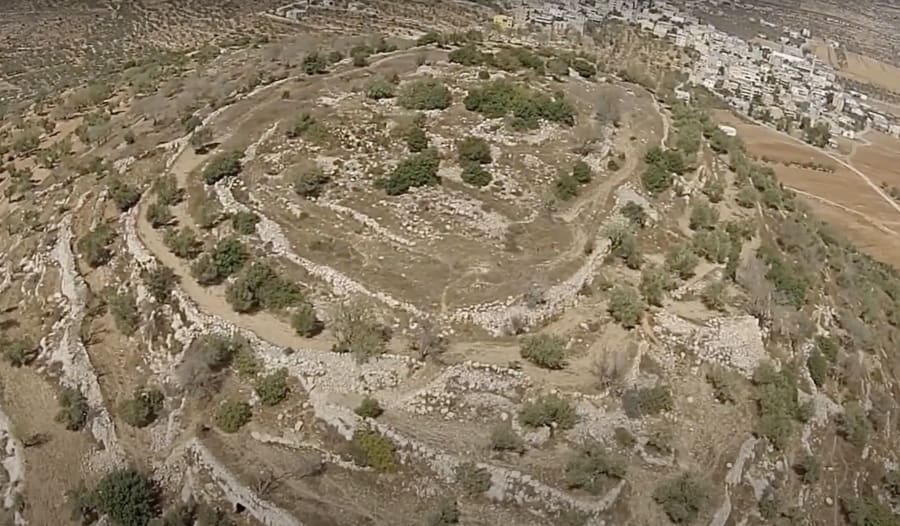Israeli archaeologist uncovers Second Temple-era fortified village
The village has been called “Kfar Lakitia,” named after one of the three Roman garrisons Emperor Hadrian stationed at the end of the Bar Kokhba Revolt

The Land of Israel Studies and Archaeology department at Bar-Ilan University has turned its focus to uncovering a fortified village believed to have existed at the time of the Bar Kokhba Revolt in 132-135 A.D.
Ruins of the Khirbet el-Qutt village can be seen near the “Lebonah Ascent” in southern Samaria, overlooking the route to Jerusalem from Samaria and Shechem (where the modern Arab town of Nablus sits). The Lebonah Ascent is surrounded by steep slopes, except where it connected to hilltops toward the south.
The village has been called “Kfar Lakitia,” named after one of the three Roman garrisons Emperor Hadrian stationed at the end of the revolt. Khirbet el-Qutt features a subterranean wine cellar that was converted into a hiding place, according to BibleWalks.com.
Dr. Dvir Raviv is leading the current excavation of Khirbet el-Qutt, whose area extends across about five acres. The late Professor Zecharia Kallai of the Hebrew University of Jerusalem’s Institute of Archaeology first surveyed the site at the end of the 1960s. Kallai reported finding remains of walls, cisterns, caves and pottery from the Early Bronze Age, as well as Iron Age II, and the Roman and Byzantine periods.
A late-1990s survey by the archaeology department of the Civil Administration in Judea and Samaria unearthed a miqveh, or Jewish ritual bath, 500 meters south-southeast of the ruins.
Another survey in late 2014 recorded a second miqveh, along with the remains of buildings, cisterns, caves, quarries, agricultural installations and burial caves.
The Ritual Miqveh
Raviv’s latest survey uncovered the remains of three ritual baths, though one miqveh was exposed recently during illegal looting of the area. The miqveh features an entrance-way with six steps leading to the small, oval-shaped immersion chamber. The walls are lined with gray plaster, typical for the Early Roman period.
The Hiding Complex
A small double-chamber subterranean complex, strewn with sherds of storage and cooking vessels – dating back to the period between the Great Revolt against the Romans and the Bar-Kokhba Revolt – indicate the former wine cellar had been used for hiding.
It is difficult to identify this complex as a hiding place due to the absence of tunnels, except for the presence of the ceramic remains. It is possible that the hardness of the surrounding stone prevented tunnels and additional rooms from being formed.
Dozens of hiding complexes found in recent years in the northern Judean Hills indicate the nature of the stone in the area often forced masons to maximally exploit pre-existing subterranean spaces, and to create short tunnels or a small, simple passage system.
Water Cisterns
Excavators uncovered six water cisterns whose walls were covered with numerous layers of plaster – a nod toward the Early Roman period, inlaid with sherds that might date to the Byzantine period. They are quite similar to the water cisterns of the Royal Hasmonean and Herodian fortresses, built throughout the Hasmonean kingdom.
Fortress or Monastery
The remains of a monumental 900-square-meter building, built of large dressed stones, was uncovered on the eastern slopes. The building style and limited pottery found at the site suggest the remains of a monastery or fort from the Late Roman or Byzantine periods.
The Necropolis
A cemetery extends to the south, consisting of at least 18 tombs. One contains ossuary fragments and a few Early Roman sherds. The number and types of tombs suggest that the site reached its maximum size during the Second Temple period.
Site History
Close to the main road and to the fertile Lebonah valley, Khirbet el-Qutt would have drawn inhabitants throughout history. Findings show evidence of occupation almost continuously from the Iron Age I until the early Muslim period, including during the Hellenistic and Roman periods.
The present survey showed that Khirbet el-Qutt’s settlement peaked during the Early Roman period, at the end of the Second Temple period. During the Byzantine period, the village’s occupants seem to have concentrated at the top of the hill and along its eastern slope, suggesting that a monastery might have stood there.
The development of settlement at the site, and its transition into a large fortified Jewish village, appear to have occurred during the late Hellenistic period, accompanied by the invasion and conquest of the area by the Hasmoneans – also known as the Maccabees. Other excavations in the area offer proof that the Hasmonean dynasty was marked by intensive settlement activity, from about 140 B.C. to 37 A.D.

The All Israel News Staff is a team of journalists in Israel.













